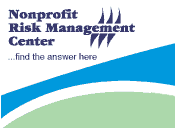| |
August 13, 2008
Risks and Rewards of Fringe Benefits in the Nonprofit Workplace
The August webinar hosted by the Nonprofit Risk Management Center highlighted both the risks and rewards of fringe benefits offered by nonprofit employers. Did you know that numerous studies have shown that employees value flexible work hours and telecommuting on a par with health insurance and other more traditional benefits, such as tuition reimbursement and performance bonuses?
Guest presenters from Richard J. Princinsky & Associates, (Hunt Valley, MD) provided an overview of “what’s new” in employee benefits as well as some cautionary notes on the risks for any nonprofit employer offering traditional and non-traditional benefits to employees.
What’s New
- Family Leave: At least three states have recently passed paid family leave laws: California, New Jersey and Washington State. Fourteen more states are considering such laws.
- Domestic Partner Benefits: An increasing number of insurance plans are offering benefits for domestic partners.
- Telecommuting: Gas prices got you down? Many nonprofits are taking a fresh look at the risks and rewards of telecommuting.
- Age of Dependency is Rising: In many states the definition of “dependent child” is changing to an older age. This means that nonprofit workers may be keeping their children as dependents on their health insurance plans longer – even through and after college.
- Consumer Driven Health Plans: The hottest item in an employer’s fringe benefits arsenal lets the employee decide where to direct dollars for his/her own health and wellness. And the best part: tax savings for the employee and the employer. Plans such as Health Savings Accounts allow employees to use pre-tax dollars to pay health care costs that may fall outside of their regular health insurance plan. The savings accounts travel with the employee when they leave their employment and can be rolled over from one year to the next. By way of comparison, Health Reimbursement Accounts can’t be rolled over and don’t travel with the employee: instead the nonprofit employer maintains ownership of the accounts but the employee is in the driver’s seat in deciding what expenses to cover.
What are the Risks?
As with any policy, equity and clarity are key. When administering any benefit policy a nonprofit employer needs to ensure fairness. Retaliating against an employee for filing insurance claims or taking advantage of health insurance benefits is illegal. Some benefits, such as COBRA and retirement plans, require employers to be extra-vigilant in notifying employees about their benefits accurately and in a timely fashion – recent cases in several jurisdictions underscore that misleading descriptions of any benefit can land the employer in very hot water.
- Here’s an example of the importance of an accurate description of benefits: A federal court in NJ recently found that an employer, who was the plan administrator for a flexible spending account for its employees, was responsible for almost $5,000 in payments to an orthodontist who had treated an employee the previous year. When the employee was hired, she received a description of the flexible spending account that simply said, “You must incur expenses by December 31st of the calendar year in which your contributions are made.” The document she received went on to refer employees to an IRS publication stating that a medical expense is “incurred” when it is paid. The employee went to the orthodontist in December of the previous year, but submitted her claim for reimbursement the following January when she received the bill from the orthodontist. The plan only reimbursed her for $600 because the plan administrator, her employer, took the position that not all the expenses were “incurred” during the plan year. The court disagreed, stating that if the employer was going to define “incur” differently from the IRS, it had a responsibility to clarify that position in the summary plan description distributed to employees.
This and several other cases demonstrate how important it is to carefully and accurately describe the benefits provided to employees.
Do you want to keep up-to-date on trends but also prepare your nonprofit for any risks along the way? Join us for the Center’s monthly webinars — the first Wednesday of the month at 2 pm EST. Subscribe to a topic that appeals to you (or more than one and receive a discount!) and tune in over a cup of coffee with colleagues. Don’t miss the rest of the series on these practical topics, relevant to your nonprofit’s mission:
Upcoming Webinars from the Center
Have a Question? Email or call us! 202-785-3891.
|


